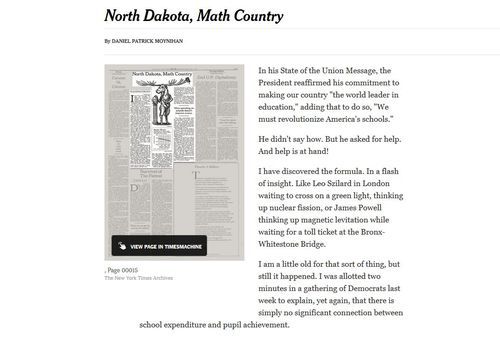 From the New York Times in 1992:
From the New York Times in 1992:
North Dakota, Math Country
By DANIEL PATRICK MOYNIHAN (Senator, D-NY)In his State of the Union Message, the President reaffirmed his commitment to making our country “the world leader in education,” adding that to do so, “We must revolutionize America’s schools.”
He didn’t say how. But he asked for help. And help is at hand!
I have discovered the formula. …
I am a little old for that sort of thing, but still it happened. I was allotted two minutes in a gathering of Democrats last week to explain, yet again, that there is simply no significant connection between school expenditure and pupil achievement.
… Uh huh, nodded the audience. Same old stuff. Then it came to me. “Fellow countrymen!” I exclaimed. “If you would improve your state’s math scores, move your state closer to the Canadian border!”
The whole room got it!
On to the Congressional Budget Office! Please, I asked, get me the correlation between math scores and distance of state capitals from the Canadian border. Back came the answer. A negative 0.522 — which may be the strongest correlation known to education, and which means that the further a capital is from the border, the lower its test score. By contrast, the correlation between expenditures and math tests is a paltry 0.203. …
Even so, the indicated course for American education is obvious. Disadvantaged states should establish summer capitals in the Thousand Islands of the St. Lawrence River, which happens to include New York State territory bordering on French-speaking Quebec.
Furthermore, those long summer evenings in St. Lawrence skiffs might be given over in part to reading the literature on educational achievement that begins with the 1966 report on Equality of Educational Opportunity, known as the Coleman Report. This study, commissioned under the Civil Rights Act of 1964, determined that after a point there is precious little association between school resources and school achievement. The resources that matter are those the student brings to the school, including community traditions that value education. Or don’t.
… The plain fact is that in a rush of findings in the 1960′s, social science disabused us of most of what we used to “know” about social issues. Generally speaking, social policy has not been able to accept this. …













